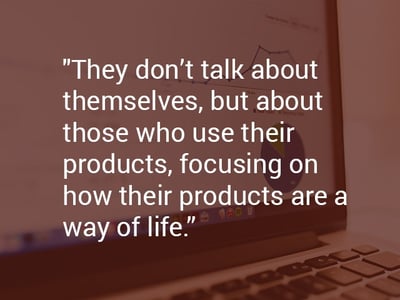In this article, we’ll answer the following questions:
- How does product design connect with marketing?
- Why does Apple focus their marketing efforts on their customers’ lives, and not on technical information?
- What is growth driven design, and how does it help brands offer value to customers?
 The name Steve Jobs means something to just about anybody. His name alone represents an entire industry’s successes, failures, and incredible innovation. The successes that he saw with Apple are all rooted in how he saw the company’s relationship with the world around it. While the practical, tangible benefits of their computers were impressive, what drove their company and brand to its mega status today is the way Steve Jobs envisioned its marketing strategies.
The name Steve Jobs means something to just about anybody. His name alone represents an entire industry’s successes, failures, and incredible innovation. The successes that he saw with Apple are all rooted in how he saw the company’s relationship with the world around it. While the practical, tangible benefits of their computers were impressive, what drove their company and brand to its mega status today is the way Steve Jobs envisioned its marketing strategies.
By exploring these ideas and strategies, we’re able to pull a few key takeaways that can help any business in any industry build stronger connections with customers.
Your Brand/Products Should Immediately Connect with Audience
When Apple was at a turning point in the late 90s, Steve Jobs was brought back to the company to help restructure its product line. The main component was focusing on how the brand resonated with Apple’s customers. Jobs maintained that a brand isn’t so much about rational arguments, but about the way the company resonated emotionally with people. His innovative creativity is what drove the development of the very first iMac. In its marketing initiatives, Jobs connected the computer to a broader audience by making sure the product’s design would immediately attract attention. iMac’s streamlined, plastic body gave it the form it needed to appeal to a broad audience, with a wide array of colors to make it stand out from more buttoned-up PCs. That innovation was the first of many as Jobs began to look at Apple’s relationship with the world around it.
The way your product speaks to your customers will drive everything. At the core of your business, how do you resonate with your consumers? It’s not necessarily a focus on all the cool tricks and applications your software can do, but how the software itself works to affect the lives of those who use it.
Products Should Be Designed with Users in Mind
Design goes beyond how your product looks and feels. Steve Jobs once said: “design is not just what it looks and feels like. Design is how it works.” Jobs’ perspective is clearly seen in Apple’s advertising and marketing, from early iPod commercials to current iPad ads. The iPod wasn’t just a device that stored music; to Apple, it was a way to take a library of music where you go. It was how you could bring your individuality with you everywhere you went. Ads never focused on storage, or on technology, but on the music. Likewise, even in today’s post-Jobs Apple marketing, you see examples of how people might use an iPad everyday to write, or design, or record music.
Your software design should go hand-in-hand with how your users will access and use it. For example, many companies overlook the importance that the user interface plays in the development of new software and applications, but when it comes down to the expectations of those users, usability itself will be the reason they stay or walk away.
Growth-Driven Design
Since the original iMac, Apple’s branding has remained clean and slick even through several different stages. As Apple’s purpose in the world changed and shifted—with the release of iPods, iPhones, Apple Watches—that branding has evolved to maintain its place in the hearts of the consumer. Sleek design has always accompanied any and all branding strategies. The use of white space, the completely colored-out dancers of the iPod commercials, it’s all going back to how Apple’s brand serves to enable its consumers to easily see themselves using their products. The key takeaway from the brand is that it still says “this product is for you.” They don’t talk about themselves, but about those who use their products, focusing on how their products are a way of life.
Marketing isn’t a one-size-fits-all kind of thing. What works today might not work tomorrow. This is why growth-driven design is so necessary for your continual success. Understand that in order to get the most out of any marketing campaign, you need to critically analyze your efforts and maximize on what works and minimize what doesn’t—it’s a work in progress. Don’t focus on producing a one-time solution, but a marketing journey that moves your business’ success through the many different challenges it faces now and tomorrow.
Your company’s success is directly tied to how you build the consumer into the product, the brand, and the way you market it all together. Steve Jobs once said: “Marketing is about values. It’s a complicated and noisy world, and we’re not going to get a chance to get people to remember much about us. No company is. So we have to be really clear about what we want them to know about us.” What’s your company’s place in the world? How are you going to make an impact in such a noisy environment?



